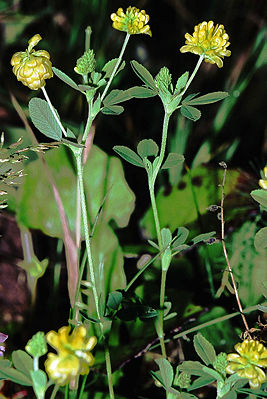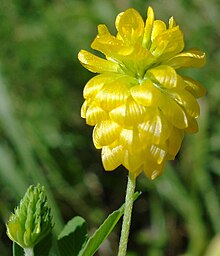Gold clover
| Gold clover | ||||||||||||
|---|---|---|---|---|---|---|---|---|---|---|---|---|

Gold clover ( Trifolium aureum ) |
||||||||||||
| Systematics | ||||||||||||
|
||||||||||||
| Scientific name | ||||||||||||
| Trifolium aureum | ||||||||||||
| Pollich |
Gold clover ( Trifolium aureum ) is a species of plant from the genus clover ( Trifolium ), which belongs to the subfamily of butterflies (Faboideae) of the leguminous plant family (Fabaceae).
description
Appearance and leaf
The gold-Klee is a one- or two-year , herbaceous plant reached, the growth heights between 20 and 60 centimeters. The adjacent hairy stems are erect or ascending and abundantly branched.
The three-part leaves are quite large and short-stalked for a clover species. The petioles are usually longer or as long as the stipules . The membrane-like stipules are elongated lanceolate, not widened at the base, clearly ribbed, elongated lanceolate and pointed. They are at least as long as the petiole and fused on at least half of their length. The leaflets are between 1.5 and 2.5 inches long and 0.6 to 0.8 inches wide. They are almost sessile and elongated, lanceolate, ovate, elliptical to rhombic. The base is wedge-shaped, the tip sharp or oblong, often truncated or edged. The edge of the upper half of the leaflets is serrated.
Generative characteristics
The flowering period extends from July to August. The terminal spike-like inflorescences are spherical with a length of 1.2 to 2 centimeters and a width of about 1.3 centimeters and contain 20 to 40 (or more) flowers. The inflorescence axes are 2 to 5 inches long. The flower stalk has a length of about 1 millimeter.
The hermaphrodite flower is zygomorphic and five-fold with a double flower envelope . The five sepals are fused into an approximately 2 millimeter high, inverted cone-shaped tube. The lower calyx teeth are twice to 2.5 times longer than the upper ones. Some of the five nailed petals are fused. The petals are first bright yellow gold, after anthesis they turn brown. The corolla is 7 to 8 millimeters high and has the typical shape of the butterfly flower . The limbus of the flag is flat or deeply spoon-shaped with a hollow, pointed basal end (nailed), not folded and clearly grooved lengthways. The lower half is serrated, the tip is deeply edged and furrowed lengthways. The wings are unusually short for a species of clover and protrude apart. The shuttle is as long as the wings. The only upper carpel is elongated and long stalked. Derterminal or laterally standing stylus is longer than the ovary.
A single-seeded legume is formed that is longer than the style. The obovate to ellipsoidal, yellowish brown seed has a diameter of about 1.2 millimeters.
The number of chromosomes is 2n = 14.
Possible confusion
The gold clover can easily be confused with the similar field clover ( Trifolium campestre ). A good characteristic of the gold clover, however, is that the end leaflet is just as short-stalked as the side leaflets. In the field clover, the terminal leaflet is much longer petiolate than the lateral leaflet.
ecology
Bees and butterflies are pollinators , and self-pollination is also possible.
Occurrence
The gold clover is a central European floral element . The area of the gold clover extends from the Pyrenees over eastern France northwards to central Sweden and southern Finland ; east to western Siberia , the Ukraine , to the Caucasus and Macedonia ; in the south it is only represented in the mountains. The natural range includes Europe completely with the exception of the British Isles. The northern border runs through southern Scandinavia. To the east, the gold clover is widespread in the Middle East as far as Lebanon and northern Iran and as far as Transcaucasia .
It occurs only sporadically in the Central European lowlands ; in the higher low mountain ranges and in the foothills of the Alps it is rare, and it is absent there in certain areas; otherwise it occurs scattered in Central Europe . In Germany , the gold clover is generally found scattered, in north-west Germany it is also absent in parts. In Austria and Switzerland the gold clover is found scattered to fairly common in the colline to subalpine altitudes .
Trifolium aureum is widespread as a neophyte in almost all of North America . It was first introduced to Pennsylvania around 1800. Neophytic occurrences also exist in Australia and New Zealand.
The golden clover colonizes gappy, poor lawns and path and forest edges in Central Europe and is often found after clear cuts. It occasionally rises to over 1200 meters in the Alps . It occurs in the Allgäu Alps near the Höflealpe in Bavaria northwest of Riezlern at 1210 m above sea level. It is sensitive to nitrogen fertilization, so it usually disappears quickly from cultivated lawns. In the fringes of the forest he avoids places with tall grasses. The golden clover thrives best on lime-poor, mostly lime-free, acidic, poor in nutrients, often somewhat raw, loamy or sandy soils . It thrives above all in societies of the Violion caninae association, but also occurs in societies of the Sedo-Scleranthetea class.
Systematics
Trifolium aureum was first published by Johann Adam Pollich .
Of Trifolium aureum two were subspecies described :
- Trifolium aureum subsp. aureum : At least the upper leaves are rounded, with short, calyx-shaped bracts and the calyx is bare.
- Trifolium aureum subsp. barbulatum Freyn et Sint. ex Freyn : At least the upper leaves are pointed, with fringed bracts and the calyx is almost as high as the crown and ciliate on the teeth. This subspecies has so far only been described from Turkey.
literature
- Michael Zohary, David Heller: The Genus Trifolium . The Israel Academy of Sciences and Humanities, Jerusalem 1984, ISBN 965-208-056-X , pp. 332-336 .
Individual evidence
Most of the information in this article has been taken from the sources given under literature; the following sources are also cited:
- ↑ Ruprecht Düll , Herfried Kutzelnigg : Pocket dictionary of the plants of Germany and neighboring countries. The most common Central European species in portrait. 7th, corrected and enlarged edition. Quelle & Meyer, Wiebelsheim 2011, ISBN 978-3-494-01424-1 .
- ^ Oskar Sebald, Siegmund Seybold, Georg Philippi (ed.): The fern and flowering plants of Baden-Württemberg. Volume 3: Special part (Spermatophyta, subclass Rosidae): Droseraceae to Fabaceae. Eugen Ulmer, Stuttgart 1992, ISBN 3-8001-3314-8 .
- ↑ a b c Dietmar Aichele, Heinz-Werner Schwegler: The flowering plants of Central Europe . 2nd Edition. tape 2 : Yew family to butterfly family . Franckh-Kosmos, Stuttgart 2000, ISBN 3-440-08048-X .
- ↑ Nicholas Turland, Jan Kirschner, Jan Štěpanek: (1244-1246) Proposals to Reject the Names Trifolium agrarium, T. filiforme and T. procumbens (Leguminosae) . In: Taxon . tape 45 , no. 3 , August 1996, p. 549-551 , JSTOR : 1224156 .
- ↑ Erhard Dörr, Wolfgang Lippert : Flora of the Allgäu and its surroundings. Volume 2, IHW, Eching 2004, ISBN 3-930167-61-1 , pp. 126-128.
Web links
- Gold clover. In: FloraWeb.de.
- Gold clover . In: BiolFlor, the database of biological-ecological characteristics of the flora of Germany.
- Trifolium aureum Pollich In: Info Flora , the national data and information center for Swiss flora . Retrieved November 17, 2015.
- Profile and distribution map for Bavaria . In: Botanical Information Hub of Bavaria .
- Thomas Meyer: Data sheet with identification key and photos at Flora-de: Flora von Deutschland (old name of the website: Flowers in Swabia )
- Profile of the Burke Museum of Natural History and Culture . (engl.)
- Distribution map in the northern hemisphere at Den virtuella floran .




